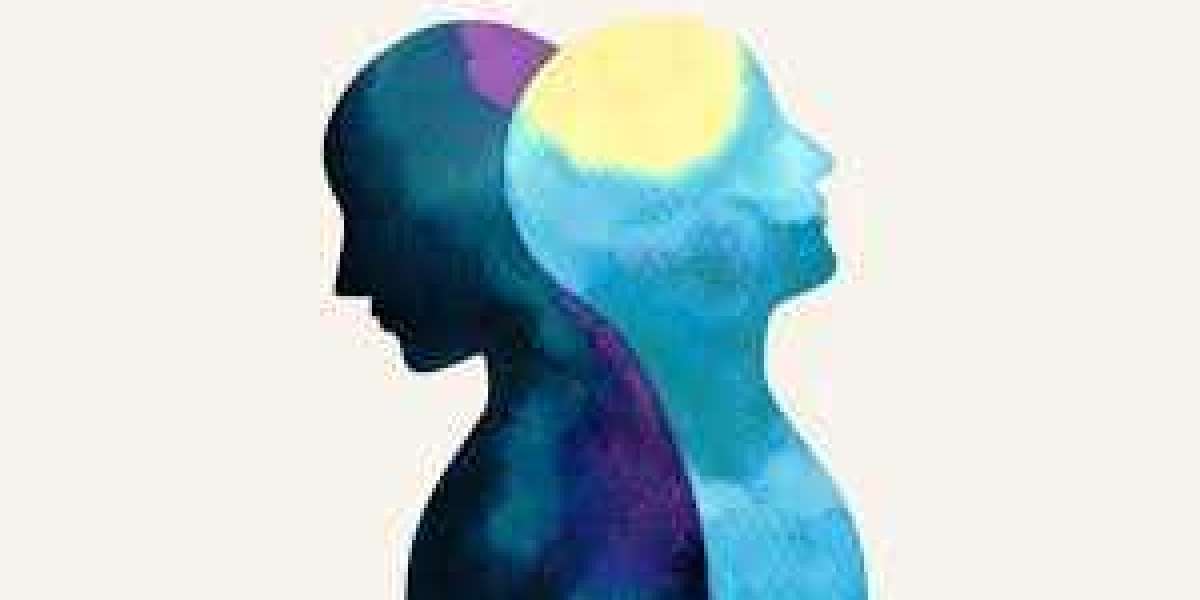Bipolar disorder, once known as manic-depressive illness, is a complex mental health condition portrays extreme mood swings that include emotional highs (mania or hypomania) and lows (depression). It is a condition that affects millions of people worldwide, cutting across cultural, demographic, and socioeconomic boundaries.
While the fluctuating mood states are often the most noticeable aspect of bipolar disorder, the underlying bipolar disorder thought patterns that accompany these mood changes are equally significant and warrant deeper understanding.
In this blog, we will delve into the intricate bipolar disorder thought patterns, exploring how they manifest during different mood states, their impact on behavior and perception, and the therapeutic strategies employed to manage them. By demystifying these thought processes, we hope to foster a more nuanced comprehension of the condition, reducing stigma and enhancing empathy towards those who navigate the complexities of bipolar disorder.
Understanding Bipolar Disorder
Types of Bipolar Disorder
Bipolar disorder is classified into several types, each characterized by different patterns of mood episodes:
Bipolar I Disorder: This type is defined by the occurrence of at least one manic episode, which may be preceded or followed by hypomanic or major depressive episodes. Manic episodes in Bipolar I are severe and often require hospitalization.
Bipolar II Disorder: Shows a pattern of depressive episodes and hypomanic episodes, but no full-blown manic episodes. The hypomanic episodes are less severe than the manic episodes in Bipolar I but still involve noticeable changes in mood and behavior.
Cyclothymic Disorder: This type involves periods of hypomanic symptoms and periods of depressive symptoms lasting for at least two years (one year in children and adolescents), but the symptoms do not meet the diagnostic requirements for a hypomanic episode and a depressive episode.
Other Specified and Unspecified Bipolar and Related Disorders: These categories include bipolar disorder symptoms that do not match the criteria for Bipolar I, II, or Cyclothymia but still involve significant mood disturbances.
Mood States in Bipolar Disorder
The primary mood states in bipolar disorder are:
Mania: During a manic episode, individuals experience abnormally elevated, expansive, or irritable moods that last at least one week. They exhibit inflated self-esteem, decreased need for sleep, talkativeness, racing thoughts, distractibility, increased goal-directed activity, and risky behavior.
Hypomania: Hypomanic episodes are similar to manic episodes but less severe and shorter in duration. They last at least four days and do not cause significant impairment in social or occupational functioning.
Depression: A major depressive episode is characterized by a period of at least two weeks with symptoms such as persistent sadness, loss of interest or pleasure in activities, changes in appetite and sleep patterns, fatigue, feelings of worthlessness or guilt, and thoughts of death or suicide.
Mixed Episodes: These episodes involve simultaneous symptoms of both mania (or hypomania) and depression. Individuals may experience agitation, irritability, high energy, sadness, hopelessness, and fatigue.
Thought Patterns in Bipolar Disorder
Bipolar disorder thought patterns are as dynamic and fluctuating as the mood states themselves. Understanding these thought processes is crucial for comprehending the full impact of the disorder.
Thought Patterns During Mania
During manic episodes, the brain's thought processes shift into overdrive. Some common bipolar disorder thought patterns during mania include:
Racing Thoughts: One of the hallmark features of mania is the rapid flow of ideas and thoughts, often described as racing thoughts. Individuals may find it challenging to focus on one idea because their minds constantly jump from one thought to another.
Grandiosity: Manic episodes often involve inflated self-esteem and grandiosity. Individuals may have an exaggerated sense of their abilities and importance, leading to unrealistic plans and goals. This can result in overconfidence and risky behaviors.
Flight of Ideas: Similar to racing thoughts, flight of ideas involves a continuous flow of accelerated speech with abrupt changes from one topic to another. This can make communication challenging, as the individual’s thoughts are disjointed and scattered.
Distractibility: During mania, individuals are easily distracted by external stimuli. This heightened sensitivity to the environment can make it challenging to stay on task and complete activities.
Impulsivity: Manic bipolar disorder thought patterns often include a tendency towards impulsive decision-making and actions without considering the potential consequences. This impulsivity can lead to financial troubles, legal issues, and strained relationships.
Thought Patterns During Depression
Depressive episodes in bipolar disorder bring about a stark contrast in thought patterns compared to mania:
Negative Thinking: A pervasive sense of negativity and pessimism dominates the thought process, which helps us understand how bipolar disorder affects thinking. Individuals may have persistent thoughts of worthlessness, guilt, and hopelessness, often leading to a distorted view of themselves and their circumstances.
Rumination: Depressive bipolar disorder thought patterns often involve rumination, where individuals repeatedly dwell on adverse events, thoughts, or emotions. This cyclical thinking can exacerbate feelings of depression and make it difficult to break free from the negative spiral.
Cognitive Distortions: Depression has various cognitive distortions, such as black-and-white thinking (viewing situations in extremes), overgeneralization (applying one negative experience to all similar conditions), and catastrophizing (expecting the worst possible outcome).
Lack of Concentration: Similar to mania, depression can also affect concentration, but in a different way. Individuals may struggle to focus, find it hard to make decisions and experience a general mental fog.
Suicidal Ideation: In severe cases, depressive bipolar disorder thought patterns can include thoughts of death and suicide. This is a critical symptom that requires immediate attention and intervention.
Mixed Episodes: The Collision of Thoughts
Mixed episodes combine elements of both manic and depressive bipolar disorder thought patterns, creating a tumultuous mental state. Individuals may experience racing thoughts alongside intense feelings of sadness or hopelessness. This can lead to a high risk of suicidal behavior, as the depressive despair is coupled with the manic energy to act on these thoughts.
The Impact of Thought Patterns on Behavior and Perception
Bipolar disorder thought patterns significantly influence behavior and perception, affecting various aspects of an individual’s life:
Personal Relationships
During manic episodes, individuals may exhibit behaviors that strain relationships, such as irritability, impulsivity, and grandiosity. They may make grand promises, squander money, or engage in risky behaviors that worry loved ones. Conversely, during depressive episodes, withdrawal, irritability, and negative thinking can create distance and misunderstandings.
Occupational Functioning
The cognitive disruptions of bipolar disorder can impair occupational functioning. Manic episodes may lead to erratic work behavior, overestimating abilities, and conflicts with colleagues. Depressive episodes can result in absenteeism, decreased productivity, and difficulty concentrating on tasks.
Self-Perception
Thought patterns during manic and depressive episodes profoundly impact self-perception. During mania, individuals may feel invincible and overly confident, while depression brings feelings of worthlessness and self-loathing. These shifts in self-perception can erode self-esteem and contribute to a fractured sense of identity.
Decision-Making
Both manic and depressive bipolar disorder thought patterns impair decision-making. Mania’s impulsivity and grandiosity can lead to reckless decisions, while depression’s negativity and indecision can result in missed opportunities and avoidance of necessary actions. Mixed episodes complicate decision-making further, as conflicting thoughts and emotions create confusion.
Therapeutic Approaches to Managing Thought Patterns
Effective management of bipolar disorder involves a combination of pharmacological and psychotherapeutic interventions aimed at stabilizing mood and addressing maladaptive thought patterns.
Pharmacological Treatments
Medications play a crucial role in stabilizing mood and reducing the severity of manic and depressive episodes. Common drugs and potential treatment of bipolar disorder include:
- Mood Stabilizers
- Antipsychotics
- Antidepressants
- Benzodiazepines
Psychotherapeutic Interventions
Psychotherapy is an essential component of treatment, helping individuals understand and manage their bipolar disorder thought patterns. Practical therapeutic approaches include:
Cognitive Behavioral Therapy (CBT): CBT helps individuals identify and challenge cognitive distortions and develop healthier thought patterns. Techniques such as cognitive restructuring and behavioral activation are particularly beneficial.
Dialectical Behavior Therapy (DBT): DBT focuses on building skills in mindfulness, emotional regulation, distress tolerance, and interpersonal effectiveness, helping individuals manage intense emotions and improve relationships.
Interpersonal and Social Rhythm Therapy (IPSRT): This therapy emphasizes maintaining regular daily routines and stable sleep patterns to prevent mood episodes.
Family-Focused Therapy: Involving family members in therapy can improve communication, reduce stress, and provide a supportive environment for managing the disorder.
Lifestyle Modifications and Self-Care
In addition to formal treatments, lifestyle modifications, and self-care strategies play a critical role in managing bipolar disorder. These include:
Regular Sleep Schedule: Maintaining a consistent sleep pattern is crucial for mood stability.
Healthy Diet and Exercise: A balanced diet and regular physical activity contribute to well-being and mood regulation.
Stress Management: Techniques like mindfulness meditation, yoga, and deep breathing exercises can help manage stress and prevent mood episodes.
Avoiding Alcohol and Drugs: Substance abuse can trigger or worsen mood episodes and should be avoided.
Support Systems
Building a solid support system is vital for individuals with bipolar disorder. Support groups, both in-person and online, provide a sense of community and understanding. Having supportive friends and family who are educated about the disorder can make a significant difference in managing symptoms.
Conclusion
Understanding the bipolar disorder thought patterns is essential for grasping the full impact of the condition. These patterns, whether they manifest as racing thoughts and grandiosity during mania or negativity and rumination during depression, profoundly influence behavior, perception, and overall quality of life. By exploring these cognitive processes, we can develop more effective therapeutic strategies and foster greater empathy towards those living with bipolar disorder.
Bipolar disorder is a lifelong journey marked by challenges but also resilience and strength. With appropriate treatment, support, and self-care, individuals with bipolar disorder can lead fulfilling lives, navigating the complexities of their minds with greater insight and control. By demystifying the bipolar disorder thought patterns, we move closer to a world where mental health is understood, accepted, and compassionately addressed.













